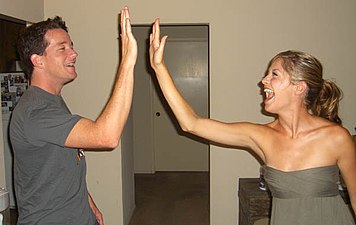Wikipedia:Wikipedia Signpost/2023-10-23/In the media
"Slate" celebrates encyclopedic selfies

In Slate, Annie Rauwerda (of Depths of Wikipedia fame) explains why "On Wikipedia, Anyone Can Be a Model". The article focuses on LittleT889, who created the article thirst trap ("a type of social media post intended to entice viewers sexually") and illustrated with a shirtless selfie of himself that has since been "viewed almost a million times" (although it was recently replaced in the article). What's more, "He adds photos of himself to all sorts of encyclopedically relevant topics, like water bottle flipping, Nae Nae, and my favorite, the Floss (dance) article, where he wears sunglasses indoors and furiously shakes his hips in front of three guitars and a bongo drum", as well as Running man (dance), Dougie, and Naruto run.
Rauwerda also managed to get in touch with other selfie contributors, such as a "20-year-old Russian university student [who said that] once he took a picture of his eye so astonishingly beautiful that an Instagram post wasn’t enough — he needed to put it on Wikipedia," and "a retired biology teacher in Germany [who] realized that Wikipedia had no good photos of female fingers [and] uploaded a snap of her own hand to Wikimedia Commons", which now illustrates the article finger. In general, the article observes that Wikipedia's "photos have an unvarnished feel and an unmistakably human charm" and that it's "immediately obvious that Wikipedia’s models are real people, not actors." It also recalls earlier media coverage of similar examples, such as a couple who has graced the high five article since 2008, and last year - now married with kids - recreated the shots for an online magazine (see earlier coverage: "The king and queen of the high 5").
- And of course we're showing it:
- "Up high."
- "Down low."
- Victim misses.
- "Too slow!" (with finger-guns)
Lastly, Rauwerda calls on Slate's readers to consider contributing themselves: "And even though Wikimedia Commons hosts more than 100 million pieces of media, it has some stunning gaps. There’s a big list of requested images, and some of the items are shockingly quotidian, like 'half-up hairstyle,' 'business women shaking hands,' and 'tripping' (go ahead, fall on your face for the sake of free knowledge)."
Wikipedia is the second-fastest website in the US
"TechNewsWorld" reports that "Craigslist, Wikipedia, and Zillow are the fastest-loading U.S. websites on the internet, according to a study released Monday by web design company DigitalSilk." Wikipedia came second "with an average load time of 1.40 seconds (1.6 mobile, 1.2 desktop)", well ahead of sloths such as Instagram ("The site on mobile takes a whopping 6.7 seconds to load and 4.2 seconds on desktop") or Google ("While it had a respectable mobile load time of 1.1 seconds, its desktop time of 4.6 seconds bloated the search giant’s overall performance").
This success is certainly in part due to the longtime work of the Wikimedia Foundation's recently disbanded Performance team, but also, according to one of the study's authors, due to Wikipedia's simpler design: "It’s interesting to see how websites like Wikipedia and Craigslist, which have barely changed their design and have remained largely text-based, topped our list, and the popularity of these sites shows that sometimes simplicity can work."
(The TechNewsWorld article doesn't link to the actual study and doesn't provide much detail about its methodology. But in a similar study featured by ZDNet earlier this year, DigitalSilk had used an online tool called Pingdom Website Speed Test.)
AI finding references
Nature News notes the publication of "Improving Wikipedia verifiability with AI" in Nature Machine Intelligence. "Wikipedia lives and dies by its references" the news article states, "but sometimes, those references are flawed." The neural network-based system described in the academic study, called SIDE, looks at whether Wikipedia references support the Wiki text, and proposes replacements for the weaker refs.
The paper is open access, licensed under the Creative Commons Attribution 4.0 International License, and can be downloaded at the above links.
Crowdsourcing 1858–1923
The Washington Post reviews the book Dictionary People by Sarah Ogilvie, a former lexicographer for the Oxford English Dictionary. The review, titled The most influential crowdsourcing project happened long before Wikipedia, focuses, like the book, on the roughly 3,000 OED contributors who sent in quotations showing words in use in printed texts. Only a dozen or so are actually named in the review, but 97 of these unpaid volunteers are recorded at Wikipedia's List of contributors to the Oxford English Dictionary.
Eadweard Muybridge hasn't yet made our list but two other murderers, Sir John Richardson (naturalist) and William Chester Minor do. Margaret Murray, who later became an Egyptologist and wrote The Witch-Cult in Western Europe, contributed 3,800 quotations from the Douay–Rheims Bible while growing up in India. There are many women among the 3,000 including Karl Marx's daughter Eleanor Aveling and a lesbian couple who wrote under the name Michael Field.
The implicit comparison of OED contributors to Wikipedians in the book review's title might seem exaggerated at first glance. After all, some of the OED contributors are quite unusual. But Ogilvie does play at comparing OED contributors with Wikipedians in the book's Introduction, which I just had to read on Amazon after reading the review. I'll have to read the rest of the book before drawing any firm conclusions. –S
In brief
- What do "Ant", "Orca", and "Erie" have in common?: Christina Iverson's husband (archive, October 10) tells her that she is "a professional Wikipedia reader." Actually, she is an Associate Puzzle Editor at The New York Times and has often visited our articles on Ant, Orca and Erie due to the words' usefulness in puzzles. More important is her belief in lifelong learning. Do you know who gave the eulogy at boxer Muhammad Ali's funeral? Or when Cheez-Its were first sold?
- Wikipedia and Bible paper were both useful to Jeff Turner, "the Picasso of counterfeiters", according to Insider via YouTube.
- Maryana Iskander at the UN: WMF's CEO spoke at a Ministerial meeting of the Freedom Online Coalition at the UN as recorded on a YouTube video and transcript.








Discuss this story
"Slate" celebrates encyclopedic selfies
Wikipedia is the second-fastest website in the US
AI finding references
This item could have benefited from a bit more context, e.g. the fact that the paper was already published last year in preprint form and received media attention back then. We covered it in both "In the media" ("Facebook experiments with Wikipedia fact-checking") and "Recent research" ( "Facebook/Meta research on "'Improving Wikipedia Verifiability with AI'") at the time, and the current story doesn't really offer any new information about this research project. That said, we might still run a fuller review in "Recent research" now that the published version of the paper is out. Regards, HaeB (talk) 19:36, 23 October 2023 (UTC)[reply]
To follow up on a remark by Piotrus (moving here, as a more suitable location):
I agree this could be super interesting. Two things to be aware of though:
Regards, HaeB (talk) 21:03, 23 October 2023 (UTC)[reply]
Breaking news
See https://twitter.com/EdKrassen/status/1716103049863663962 and The Hill. Elon Mush offers $1 Billion if Wikipedia will change it's name to "Dickypedia" for 1 year. @JPxG: I got dibs on this story for the next issue! Smallbones(smalltalk) 20:12, 23 October 2023 (UTC)[reply]